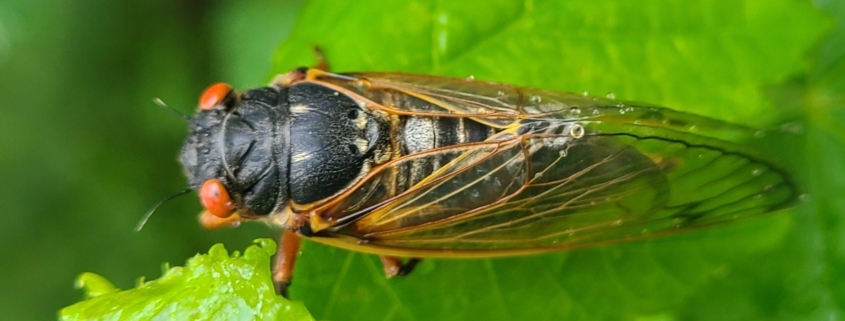Cicadas! Cicadas Everywhere!
Article and photo by FMN Ana Leilani Ka’ahanui, also of Capital Nature
What’s that late spring, early summer buzz, that loud chorus in the trees, all over the DC metro area? The 17-year periodical cicadas have made their entrance, to the fascination and delight of nature lovers in our region. While some may fear the emergence of a billion insects, many are reveling in this natural wonder, as evidenced by the explosion of cicada photos on social media. There’s even a phone app for reporting sightings. Cicada Safari will record and track your discoveries on a live map, and help scientists collect valuable data.
Want to learn what the fuss is all about? Visit Cicada Mania for everything you need to know about the 3 periodical species of Brood X: Magicicada septendecim, Magicicada cassini and Magicicada septendecula. And great radio programming by WAMU’s environmental reporter Jacob Fenston. While most cicadas have red eyes, did you know that some have white, gray, blue, or multi-colored eyes? Learn more fun facts like this by playing Brood X Bingo.
As the ground is now well above 64 degrees, Brood X is emerging to climb trees and plants to molt, then head to the treetops for some raucous partying to mate. Females lay their eggs in trees and the nymphs will later drop onto the ground, where they will burrow down and live till the next emergence party in 17 years. Their life cycle is a short 5-6 weeks and has been documented in this Return of the Cicadas video.
Dr. Michael Rapp is an entomologist at the University of MD and an excellent local authority on cicadas. Check out his media appearances at The Bug Guy. The New York Times covered all things cicada in great detail in this article. USDA entomologist Dr. Sammy Ramsey explains the science behind their loud calls. If you’re feeling adventurous, here’s a Washington Post article about recipes for cooking them.
Cicadas can be artists too. During the recent global City Nature Challenge, Teresa Leonardo discovered that cicadas had burrowed tunnels under some tarps in her yard in West Falls Church, VA in their effort to emerge. See their intricate patterns on iNaturalist.
According to the National Wildlife Federation: “Cicadas are mostly beneficial. They prune mature trees, aerate the soil, and once they die, their bodies serve as an important source of nitrogen for growing trees. When cicadas come out, they’re eaten by just about anything with an insectivorous diet.” As nature’s grand buffet, these curious creatures are providing entertainment and education for all ages.




